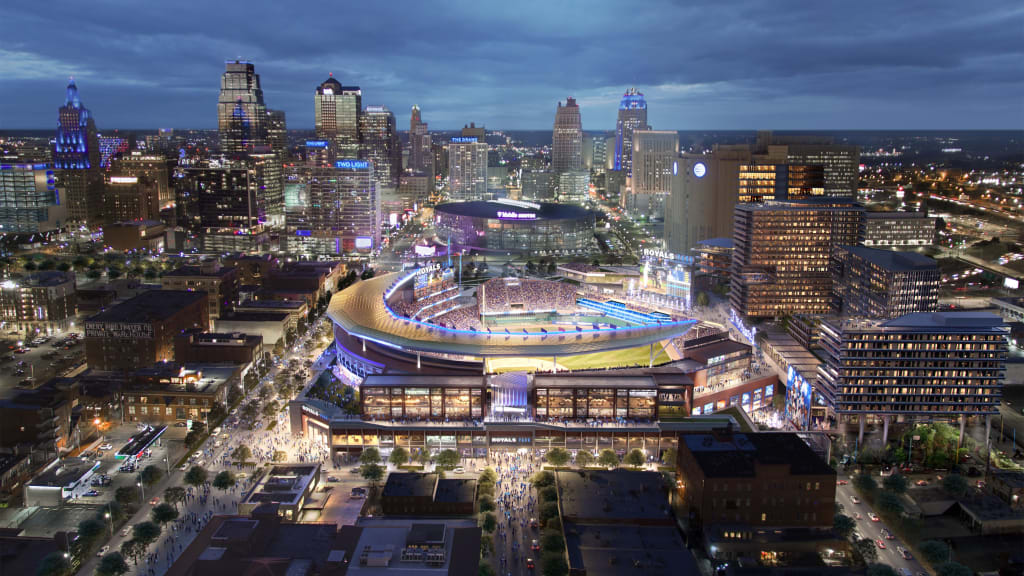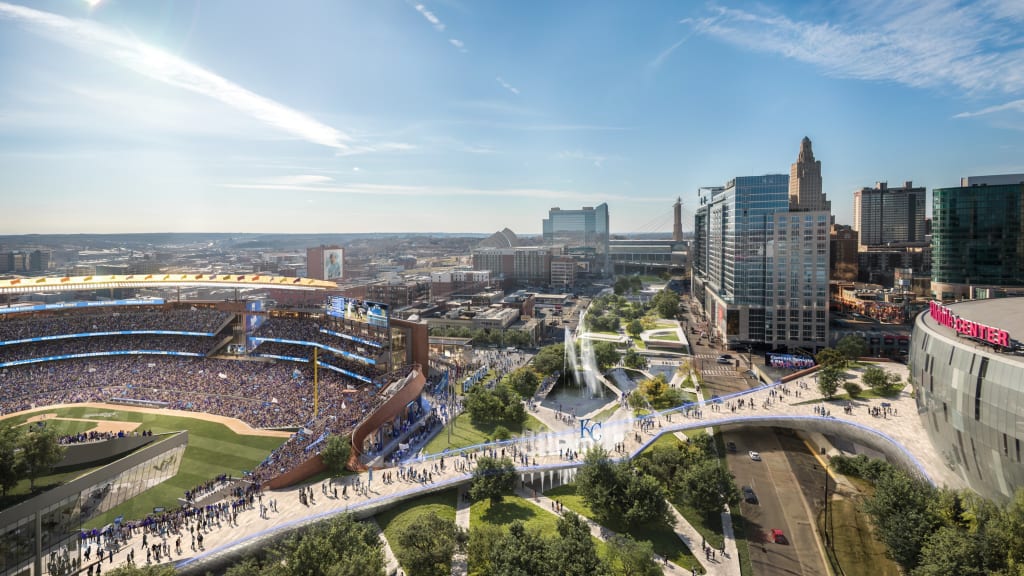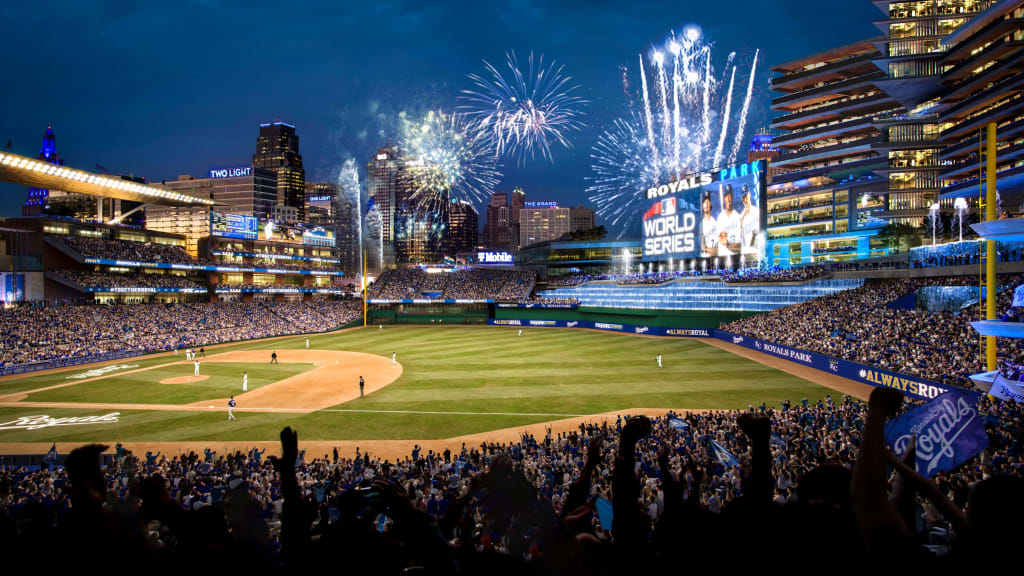KANSAS CITY -- The Royals have long dreamed of moving to downtown Kansas City. At long last, there’s an exact location where they envision their new home.
On Tuesday at Kauffman Stadium, the Royals presented their plans to build a new ballpark and surrounding entertainment district in the Crossroads District in downtown Kansas City.
“Kansas City is a special place,” Royals CEO/chairman John Sherman said. “We have outperformed many of our peers for our care for the heart of our city. Look at the residential growth downtown and the dynamism of the development and redevelopment of the Crossroads. The arts, the music, the food and drink.
“I believe in my gut that the timing is right for the Royals to become residents of the Crossroads and neighbors to Power & Light, 18th & Vine and Hospital Hill, helping to further connect the cultural center for our great city.
“We’re thrilled to announce our plans to contribute community dynamics, an incredible fan and stadium experience, and long-term growth to the Crossroads -- a neighborhood ballpark home to the Royals that will stand strong for the next 50 years here in Jackson County.”

The proposed new ballpark location is a 17.3-acre site bounded by Grand Boulevard to the west, Locust Street to the east, Truman Road to the north and 17th Street to the south. It would incorporate the former Kansas City Star printing press building at 1601 McGee St. along downtown’s south loop, just a few blocks away from the Power & Light District.
The 34,000-capacity ballpark would be facing northeast, with home plate off Grand Boulevard. Off Locust Street will be corporate offices, a new hotel and residential and entertainment venues.
A key factor in the Royals’ location decision was the South Loop Park Project, which would build a park over four blocks of Interstate 670 as it passes through downtown. The city is in the process of raising money for the $217 million project, and the current plan to cap the four blocks west of Grand Boulevard would be extended three blocks further to the east. How that extension is paid for is still to be determined.
The Royals landed on this site because it connects the team to the neighborhood, the ease of access and the abundance of parking available already. According to Earl Santee, CEO and founder of the ballpark architectural design firm Populous, the new stadium would be within a 10-minute walk of 40,000 parking spaces, compared to the 26,000 spaces at the Truman Sports Complex now.
It was also the only site the Royals looked at that didn’t require major highway improvements.
“This will be the epicenter of the sports and entertainment district for Kansas City,” Santee said. “Along with T-Mobile [Center] right across 670, the relationship to all the cultural aspects of Kansas City is within a 10-minute walk. It’s very easy for you to do multiple things in a given day, between the Kauffman Arts Center, T-Mobile, Municipal Auditorium, Power & Light District, all the other functional events and entertainment and sports activities that happen.
“I would say this is the most unique site, one of the most dense sports and entertainment sites we have in America today.”
This still rests in the hands of Jackson County voters, who will decide whether to fund the project in a special election on April 2. The question posed is whether the current 3/8-cent sales tax -- which goes to the Truman Sports Complex, where the Royals and Kansas City Chiefs currently play -- should be extended to the next 40 years (the length of the new lease).
That tax would send equal dollars to the Chiefs to renovate Arrowhead Stadium in its current location.
Public funding would cover some of what the Royals need to execute their vision for an estimated $2 billion ballpark and district. The rest will come from private funding, the team said.

The Royals hope to have their new stadium ready by Opening Day 2028. Their current home, Kauffman Stadium, opened in 1973.
One of the next steps now is to actually acquire the land where they want the new ballpark to be. It’s an area that currently houses local businesses and restaurants, and the Royals will be buying from the individual landowners and then conveying the land to Jackson County, which would own the stadium. Negotiations with those property owners are ongoing.
“There’s more to do there,” Royals president Brooks Sherman said. “But we want to go in and help in all ways, transact with them in a good way and get this accomplished for the better of the city and everyone involved.”

The former Star pavilion -- a big, green glass building -- was vacated in 2021. It’s now owned by the Privitera family, and the land would be the focal point of the new stadium.
The Royals had previously examined sites at the East Village area and another in North Kansas City. Those two were named as the finalists last summer, when the team released renderings of both sites, but over the winter, the team began pursuing the Crossroads District again.
“This process went a little bit longer than we had hoped,” Sherman said. “As you would expect, it allowed time for creative ideas to percolate. This site began to emerge [because of] a combination of some creative people, some forward thinking. … And then the catalyst of the South Loop Park, with not only the ability to raise the odds and assure its completion, but to expand it.”
The press conference on Tuesday answered the biggest question -- a site selection -- and some others looming over the team as it prepares a campaign to secure a “yes” vote in April. Officials said progress is ongoing toward a lease agreement with the county and a community benefits agreement.
